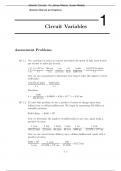Circuit Variables
Assessment Problems
AP 1.1 Use a product of ratios to convert two-thirds the speed of light from meters
per second to miles per second:
✓2
3◆3⇥108m
1s·100 cm
1m·1 in
2.54 cm·1 ft
12 in·1 mile
5280 feet=124,274.24 miles
1s.
Now set up a proportion to determine how long it takes this signal to travel
1100 miles:
124,274.24 miles
1s=1100 miles
xs.
Therefore,
x=1100
124,274.24=0.00885 = 8 .85⇥10�3s=8 .85 ms.
AP 1.2 To solve this problem we use a product of ratios to change units from
dollars/year to dollars/millisecond. We begin by expressing $10 billion in
scientific notation:
$100 billion = $100 ⇥109.
Now we determine the number of milliseconds in one year, again using a
product of ratios:
1 year
365.25 days·1 day
24 hours·1 hour
60 mins·1 min
60 secs·1 sec
1000 ms=1 year
31.5576 ⇥109ms.
Now we can convert from dollars/year to dollars/millisecond, again with a
product of ratios:
$100 ⇥109
1 year·1 year
31.5576 ⇥109ms=100
31.5576= $3 .17/ms.
1–11
© 2019 Pearson Education, Inc., 330 Hudson Street, NY, NY 10013. All rights reserved. This material is protected under all copyright laws as they currently exist. No portion of this material may be reproduced, in any form or by any means, without permission in writing from the publisher. (Electric Circuits, 11e James Nilsson, Susan Riedel)
(Solution Manual all Chapters) 1–2 CHAPTER 1. Circuit Variables
AP 1.3 Remember from Eq. 1.2, current is the time rate of change of charge, or i=dq
dt
In this problem, we are given the current and asked to find the total charge.
To do this, we must integrate Eq. 1.2 to find an expression for charge in termsof current:
q(t)= Zt
0i(x)dx.
We are given the expression for current, i, which can be substituted into the
above expression. To find the total charge, we let t!1 in the integral. Thus
we have
qtotal=Z1
020e�5000xdx=20
�5000e�5000x����1
0=20
�5000(e�1�e0)
=20
�5000(0�1) =20
5000=0.004 C = 4000 µC.
AP 1.4 Recall from Eq. 1.2 that current is the time rate of change of charge, or
i=dq
dt. In this problem we are given an expression for the charge, and asked to
find the maximum current. First we will find an expression for the current
using Eq. 1.2:
i=dq
dt=d
dt1
↵2�✓t
↵+1
↵2◆
e�↵t�
=d
dt✓1
↵2◆
�d
dt✓t
↵e�↵t◆
�d
dt✓1
↵2e�↵t◆
=0�✓1
↵e�↵t�↵t
↵e�↵t◆
�✓
�↵1
↵2e�↵t◆
=✓
�1
↵+t+1
↵◆
e�↵t
=te�↵t.
Now that we have an expression for the current, we can find the maximumvalue of the current by setting the first derivative of the current to zero andsolving for t:
di
dt=d
dt(te�↵t)=e�↵t+t(�↵ )e↵t= (1�↵t)e�↵t=0.
Since e�↵tnever equals 0 for a finite value of t, the expression equals 0 only
when (1 �↵t) = 0. Thus, t=1/↵will cause the current to be maximum. For
this value of t, the current is
i=1
↵e�↵/↵=1
↵e�1.
© 2019 Pearson Education, Inc., 330 Hudson Street, NY, NY 10013. All rights reserved. This material is protected under all copyright laws as they currently exist. No portion of this material may be reproduced, in any form or by any means, without permission in writing from the publisher. Problems 1–3
Remember in the problem statement, ↵=0.03679. Using this value for ↵,
i=1
0.03679e�1⇠=10 A.
AP 1.5 Start by drawing a picture of the circuit described in the problem statement:
Also sketch the four figures from Fig. 1.6:
[a]Now we have to match the voltage and current shown in the first figure
with the polarities shown in Fig. 1.6. Remember that 4A of current
entering Terminal 2 is the same as 4A of current leaving Terminal 1. Weget
(a)v=�20 V,i =�4 A; (b) v=�20 V, i= 4 A;
(c)v= 20 V, i=�4 A; (d) v= 20 V, i= 4 A.
[b]Using the reference system in Fig. 1.6(a) and the passive sign convention,
p=vi=(�20)(�4) = 80 W.
[c]Since the power is greater than 0, the box is absorbing power.
AP 1.6 [a]Applying the passive sign convention to the power equation using the
voltage and current polarities shown in Fig. 1.5, p=vi. To find the time
at which the power is maximum, find the first derivative of the powerwith respect to time, set the resulting expression equal to zero, and solvefor time:
p= (80 ,000te
�500t)(15te�500t) = 120 ⇥104t2e�1000t;
dp
dt= 240⇥104te�1000t�120⇥107t2e�1000t=0.
Therefore,240⇥10
4�120⇥107t=0.
© 2019 Pearson Education, Inc., 330 Hudson Street, NY, NY 10013. All rights reserved. This material is protected under all copyright laws as they currently exist. No portion of this material may be reproduced, in any form or by any means, without permission in writing from the publisher. 1–4 CHAPTER 1. Circuit Variables
Solving,
t=240⇥104
120⇥107=2⇥10�3= 2 ms.
[b]The maximum power occurs at 2 ms, so find the value of the power at 2
ms:
p(0.002) = 120 ⇥104(0.002)2e�2= 649.6 mW.
[c]From Eq. 1.3, we know that power is the time rate of change of energy, or
p=dw/dt. If we know the power, we can find the energy by integrating
Eq. 1.3. To find the total energy, the upper limit of the integral is
infinity:
wtotal=Z1
0120⇥104x2e�1000xdx
=120⇥104
(�1000)3e�1000x[(�1000)2x2�2(�1000)x +2 )�����1
0
=0�120⇥104
(�1000)3e0(0�0+2 )=2 .4 mJ.
AP 1.7 At the Oregon end of the line the current is leaving the upper terminal, and
thus entering the lower terminal where the polarity marking of the voltage is
negative. Thus, using the passive sign convention, p=�vi. Substituting the
values of voltage and current given in the figure,
p=�(800⇥103)(1.8⇥103)=�1440⇥106=�1440 MW.
Thus, because the power associated with the Oregon end of the line is
negative, power is being generated at the Oregon end of the line andtransmitted by the line to be delivered to the California end of the line.
© 2019 Pearson Education, Inc., 330 Hudson Street, NY, NY 10013. All rights reserved. This material is protected under all copyright laws as they currently exist. No portion of this material may be reproduced, in any form or by any means, without permission in writing from the publisher.




